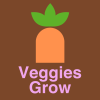Only certain parts of each type of vegetable plant are edible at a certain stage or stages during the plant’s growth. This is because other parts of the plant are poisonous, too fibrous, or simply not that tasty either all the time or all stages, or during a particular stage of plant growth. These edible parts of plants that are used in rather large quantities in a meal are known as vegetables.
In stores, only the commonly eaten parts of vegetable plants are usually available for purchase. It’s a bit different when you grow vegetables at home because you can use all parts of your plants that are edible – you can try out edible parts of vegetable plants that are not commonly eaten. An example is the leaves of carrot plants.
This means that as a vegetable gardener, you should know to identify all edible parts so that you can:
- make full use of your vegetable plants.
- to know when to harvest.
- to know which parts of plants can be regrown.
- to be able to grow a mix of vegetables with different edible parts.
Classification of vegetables based on edible parts
Various parts of plants, including the roots, rhizomes, tubers, bulbs, stems, leaves, fruits, and flowers, can be considered as vegetables. Despite this, even when two plants are closely related, the same parts of each plant may not be edible – see an example of potato towards the end of this post.
Fruiting Vegetables
Many summer vegetables are botanically the fruits of the plant because they are the fleshy structures of the plant in which fertilized seeds grow and mature. Examples of fruits that are used as vegetables are peppers, chilies, tomato, eggplant, and all gourds, which includes pumpkin, squash, cucumber, and luffa.
Pod Vegetables
Pods are also the botanical fruits of the plant, but these are usually harvested when they are still tender and green before they become too fibrous to be eaten. The entire pod is usually eaten but sometimes only the seeds in the pod may be usually eaten. Examples of pod vegetables are okra, green bean, long bean, and pea.
Leafy Vegetables
The leaves of many plants are eaten as vegetables. For example, spinach, amaranth, lettuce, and cabbage are mainly grown for their leaves. Although not grown primarily for their leaves, the leaves of carrot, beet (beetroot), chard, cauliflower, and okra (tender leaves only) plants are all edible.
Herbs are usually not considered as leafy vegetables because we eat them in smaller quantities and mainly use them to flavor food. Despite this, herbs are ideal companions for vegetable plants.
Flowers that can be eaten as Vegetables
The immature flower heads of cauliflower, broccoli, and artichoke plants are harvested and used as vegetables. Flowers of scarlet runner beans, chives, borage, and squash are also edible.
Stem Vegetables
In celery, asparagus, fennel, and kohlrabi plants it is the stem that is usually eaten and commonly used as a vegetable.
Root Vegetables
In vegetables that grow below the ground, it can be difficult to tell whether it is the root, bulb, rhizome, or tuber that has been harvested.
The entire root is usually eaten in root vegetables and each plant produces just one vegetable each. Examples of root vegetables are carrot, radish, turnip, beetroot, and yams. This is also why once a carrot has been cut off and the stump is planted, only leaves and eventually flowers will grow but a new carrot will not grow.
Bulbs, Rhizomes, and Tubers as Vegetables
On the other hand, rhizomes, tubers, and bulbs are not really roots but are modified plant stems. A distinguishing feature of rhizomes is that they grow horizontally. Rhizomes that are used as a vegetable include ginger, turmeric, and lotus.
Tuber vegetables look remarkably similar to roots but usually produce more than one vegetable per plant. Examples of tuber vegetables are potato, sweet potato, cassava, and taro. Tubers grow stems from the “eyes” on them. Each tuber will have a couple of eyes on it allowing you to grow more than one plant from each.
Plants with edible bulbs include onion, garlic, and leek. Each onion bulb will grow only one plant but quite often it will grow other baby bulbs, known as offsets, from the base. Garlic bulbs need to be split into individual cloves before being planted. Each clove will grow into a new plant.
Completely edible vegetable plants
In some vegetable plants, all parts of the plant are edible. For example, although the bulb of the onion plant is the part most frequently eaten, onion leaves and flowers can also be eaten. Similarly, even though only the roots of the carrot plant and beetroot plant are usually considered vegetables, the leaves and stems of these plants are also edible.
Parts of plants that are not edible
It is important to know which parts of a vegetable plant are edible and which parts should not be eaten. In some vegetable plants, only a certain part of the plant is edible, while other parts can be toxic for humans.
An example of this is the potato plant. The part which is known as a potato is the tuber. Potato plants eventually bear fruits that look very much like tomatoes because they in fact belong to the same family of plants, but these fruits are not edible because they contain solanine, a toxic compound.
Different parts of plants are harvested and used as vegetables. Knowing which part of the plant you are harvesting and what other parts can be harvested is helpful when you grow your own vegetables at home.
Are there other lesser-known parts of vegetable plants that you usually eat or have tasted? Let us know in the comments below.
You may also be interested in:
- Classification of Vegetables according to Plant Families
- 4 Steps for Choosing the Best Vegetables for Your Garden

